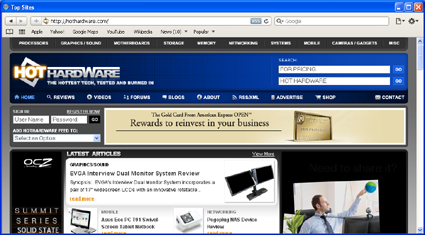A Closer Look At Safari 4: How Does It Stack Up?
Introduction to Safari 4

One of the nicer things about Safari 4 is that Apple has made it available for both Windows (XP and Vista) as well as its own OS X operating system. It's also built around the Nitro engine, which--according to Apple runs JavaScript up to 4.5 times faster than the prior instance of Safari, nearly 8 times faster than Internet Explorer 8 and over 4 times faster than Firefox 3. It also supports HTML 5 and advanced CSS effects, and Apple claims that it can load HTML web pages over 3 times faster than IE 8 and Firefox 3. Apple also added a number of new, unique features that help to set this browser apart from the rest: Top Sites, Full History Search and Cover Flow.
Safari 4 Google Search Box; Click To Enlarge
It's hard to knock Apple for its innovation in the browser space. After all, the world's best browsing cellphone came from the labs at Cupertino (the iPhone), and the open source WebKit engine is widely regarded as the cream of the crop. In fact, Apple trumpets the fact that Safari 4 is the first browser to ever pass the Web Standards Project’s Acid3 test, which examines how well a browser adheres to CSS, JavaScript, XML and SVG standards that are specifically designed for dynamic web applications. Safari 4 also integrates a few features found on other Apple products, namely Cover Flow--which enables users to flip through web history or bookmarks--as well as Top Sites, which acts as an Expose of sorts, but for web sites you frequently visit.

Acid 3 100% Pass on Safari 4








